Ecuador are a proud footballing nation, but amidst the likes of Brazil, Argentina, Uruguay, Colombia and Chile, they have always been relative minnows in South American football. La Tri are currently in 53rd place in the FIFA World Rankings, which makes them the second-lowest South American team, only ahead of Bolivia in 81st place. This is an accurate representation of Ecuador’s position in the South American football hierarchy. However, the team has had some encouraging moments in the not-too-distant past, qualifying for the World Cup for the first time in 2002, while they also made the quarter-finals of the Copa America Centenario in 2016. Ecuador’s best finish at the Copa America is fourth place, achieved twice, in 1959 and 1993, and while emulating that performance may be a step too far, they will be hoping to at least make it to the quarter-finals, given the format of this tournament, which sees the 10 teams divided into two groups of five on the basis of geography, with the top four teams in each group going through. Ecuador therefore only need to not be the worst side in their group, but even this is not as easy as it sounds, with Brazil, Colombia, Venezuela and Peru as the other teams alongside them. However, they have had some huge wins under new manager Gustavo Alfaro, who only took charge in August 2020, but has already overseen wins over Uruguay and Colombia, among others, in the South American section of the 2022 World Cup qualifiers. El Tri will therefore go into this tournament with hope and confidence, and they could be a tricky opponent for any side if they manage to make it into the knockout stages.
THE SQUAD (predicted)
Goalkeepers:
Alexander Domínguez (C)
Hernán Galíndez
Moisés Ramírez
Defenders:
Robert Arboleda
Xavier Arreaga
Byron Castillo
Pervis Estupiñán
Mario Pineida
Jackson Porozo
Ángelo Preciado
Midfielders:
Moisés Caicedo
Alan Franco
Carlos Gruezo
Fidel Martínez
Ángel Mena
Jhegson Méndez
Christian Noboa
Gonzalo Plata
Renato Ibarra
Romario Ibarra
Forwards:
Leonardo Campana
Michael Estrada
Enner Valencia
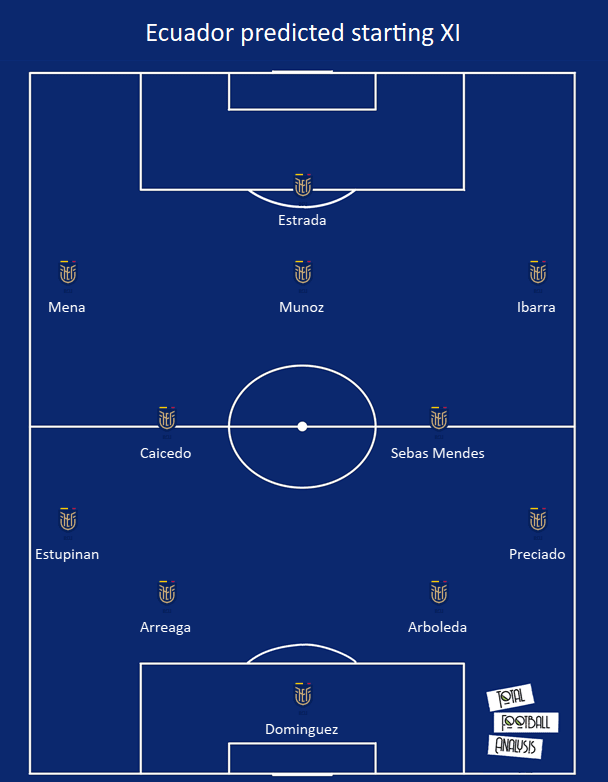
Under Alfaro, Ecuador have been quite flexible, using the 4-1-4-1, 4-4-2 and 4-2-3-1 formations in five matches. Ecuador have only lost one of them, a 1-0 defeat to Argentina, while the aforementioned victories over Uruguay and Colombia were big ones – 4-2 and 6-1, respectively, with two wins over Bolivia as well, putting them in third place in the standings at the moment. Ecuador’s squad may not have too many big names, but there are some quality players who could go on to make a name for themselves at this tournament.
Veteran goalkeeper Alexander Domínguez will start between the sticks, with a back four of Pervis Estupiñán, Xavier Arreaga, Robert Arboleda and Ángelo Preciado in front of him. Of these, Estupiñán will probably be the most recognizable name – the 23-year-old left-back was on Watford’s books for four years, during which time he was out on loan at Granada, Almeria, Mallorca and Osasuna, before being sold to Villarreal this summer, with whom he has just won the UEFA Europa League. Arboleda and Arreaga have formed a solid partnership at centre-back for quite a few matches now, while Preciado will also provide energy and thrust from right-back. The rest of the defensive unit is quite inexperienced in terms of international caps, and Alfaro has tried to bring through younger players throughout the squad in this manner, as we shall see.
Moisés Caicedo, who joined Brighton in January, will be one of the two holding midfield players, with Jhegson Méndez of Orlando City likely to partner him. The experienced Christian Noboa can come into the side as a defensive midfielder, while if Alfaro wants to play with a number 10 instead, we can expect to see Ángel Mena come into the side. Mena can also play out on the flanks, while the likes of Jhegson Méndez, José Cifuentes, Fidel Martínez and Alan Franco offer alternatives across these positions.
Mena is likely to be a key part of the XI, whether as the central playmaker or out wide, while the Ibarra brothers, Romario and Renato, are also options out wide, along with Sporting Portugal winger Gonzalo Plata, and Fenerbahçe attacker Enner Valencia. Valencia can play as the central striker as well, with Michael Estrada expected to lead the line, and Leonardo Campana offering backup alongside Valencia.
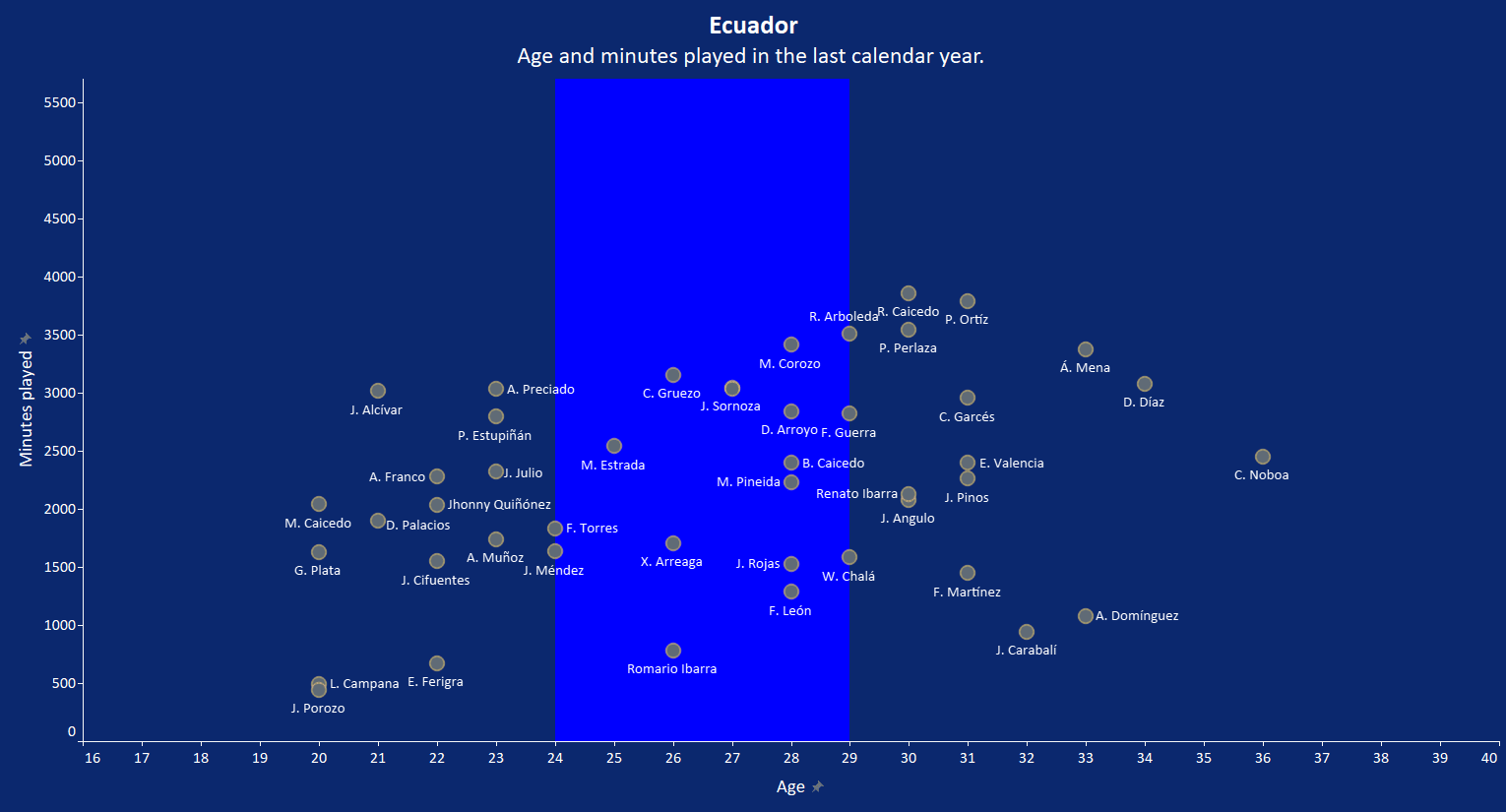
Looking at the age profile of this group, there is almost an equal split between young prospects, those at their peak, and more experienced veterans. The likes of Mena, Valencia, Noboa and Domínguez offer experience and leadership in the dressing-room, while some of the most important players of the side, such as Estrada, Arreaga, Gruezo and Arboleda are in their peak years. Finally, Caicedo, Plata, Cifuentes, Preciado, Estupiñán and Franco are all still quite young, but will have big roles to play for Ecuador, not just at this tournament, but in the years to come as well. Overall, Alfaro has done a good job of assembling a well-balanced group of individuals, in terms of age, experience and playing profiles.
ATTACKING PHASE
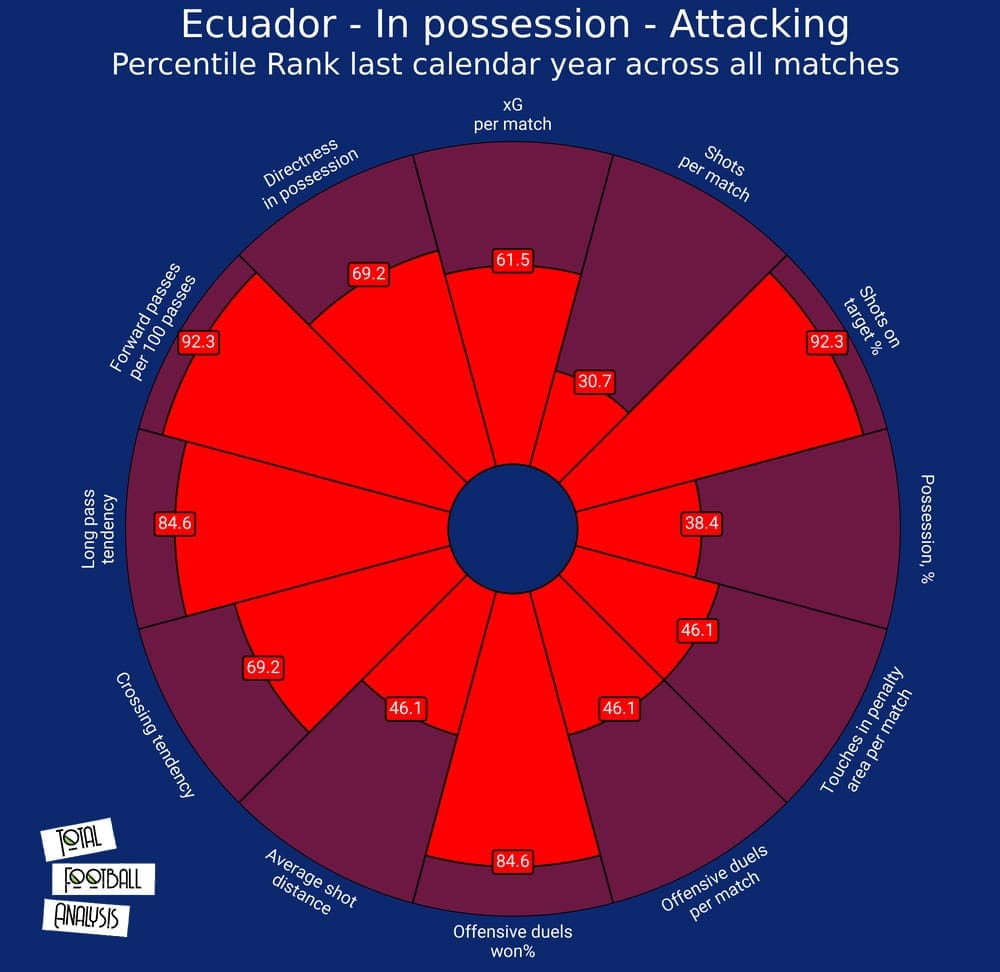
The radars in this piece are based on an admittedly small sample size, as the COVID-19 pandemic meant that Ecuador played just five games in the last calendar year. However, all of these matches were under the new coach, so they do provide us with some idea of his philosophy and principles. Looking at these metrics, we can get a fair idea of Ecuador’s strategy in possession, and it is clear that they are a fairly direct team, ranking high for forward passes per 100 passes (92nd percentile), directness in possession (69th percentile) and long pass tendency (84th percentile), with a low rank for possession (38th percentile). It is also encouraging that this style has helped them create a decent amount of chances as well, as seen by the rank for xG per match (61st percentile), but it is slightly worrying that they rank low for shots per match (30th percentile). When combined with the high rank for shots on target % (92nd percentile), it is clear that Ecuador have been able to get into good goalscoring positions in their last few matches, but have not done so quite frequently enough, as also seen by their rank for touches in the box (46th percentile). Overall, this is not too bad – it suggests that Ecuador’s direct style of play suits their players, and they have been able to create high-quality chances through this approach, albeit the number of those chances needs to be increased, as we suspect that Ecuador will not be able to keep up the efficiency of finishing that has brought them so many goals in their last five matches, and therefore must increase the quantity of chances created.
In the build-up phase, Ecuador utilise a number of strategies, but the most common shape seen is a 4-2-4, with the full-backs pushing high and wide, and the wingers coming infield to form a front four with the striker and attacking midfielder.
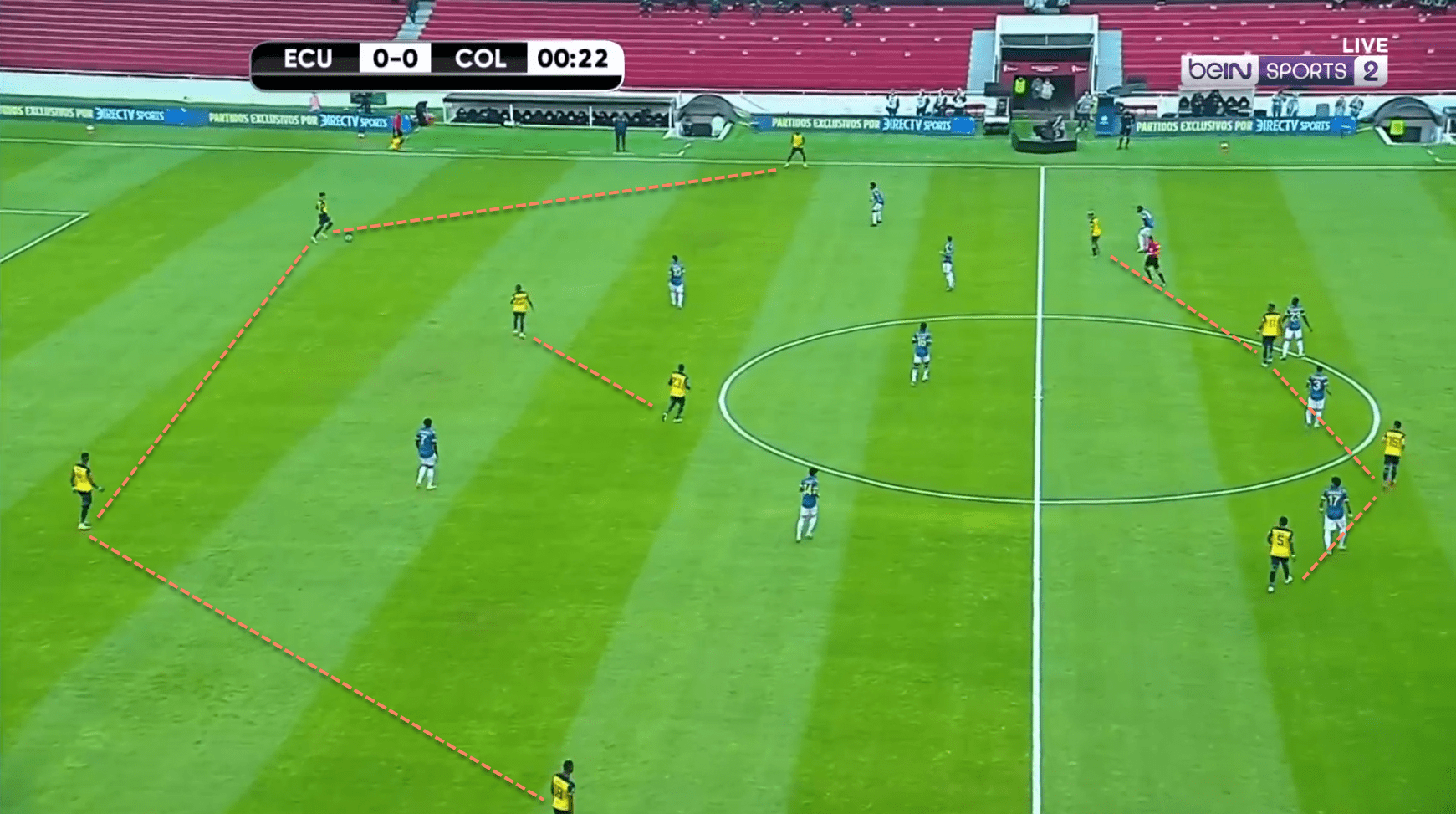
However, another common strategy is to move to a back three to allow the full-backs to get even further forward. This is done either by having one of the central midfielders drop in, or with one of the full-backs tucking in, leaving the other one to move upfield.
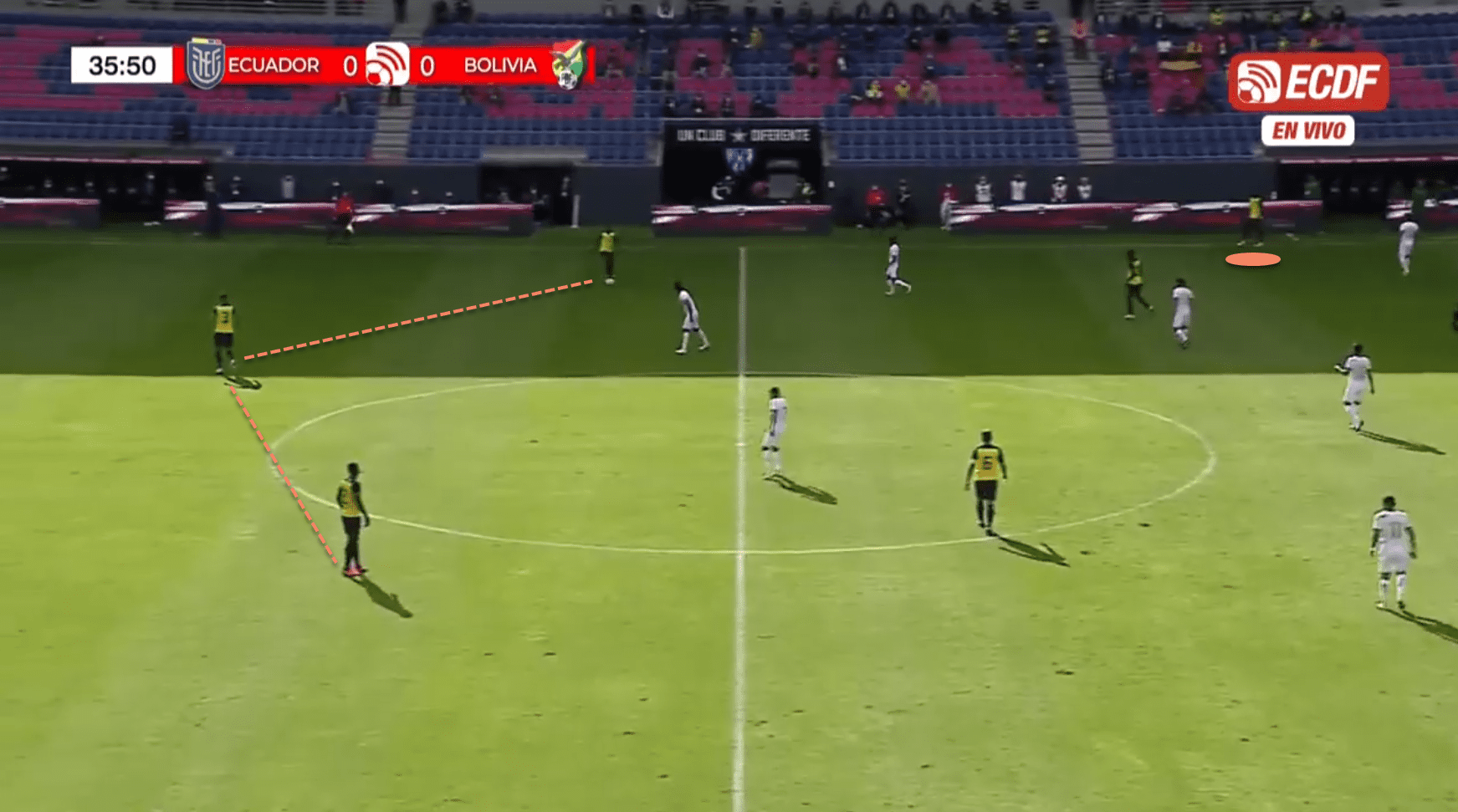
Here, it is the right-back who has stayed deeper, while the left-back is allowed to move high up the pitch.
Ecuador try to utilise the wide spaces as much as possible when attacking – as we have seen, they will push the full-backs high to facilitate this, but also have one of the central midfielders moving wider in support of the winger on occasion, to play quick passing moves and release players behind the opposition’s defensive line.
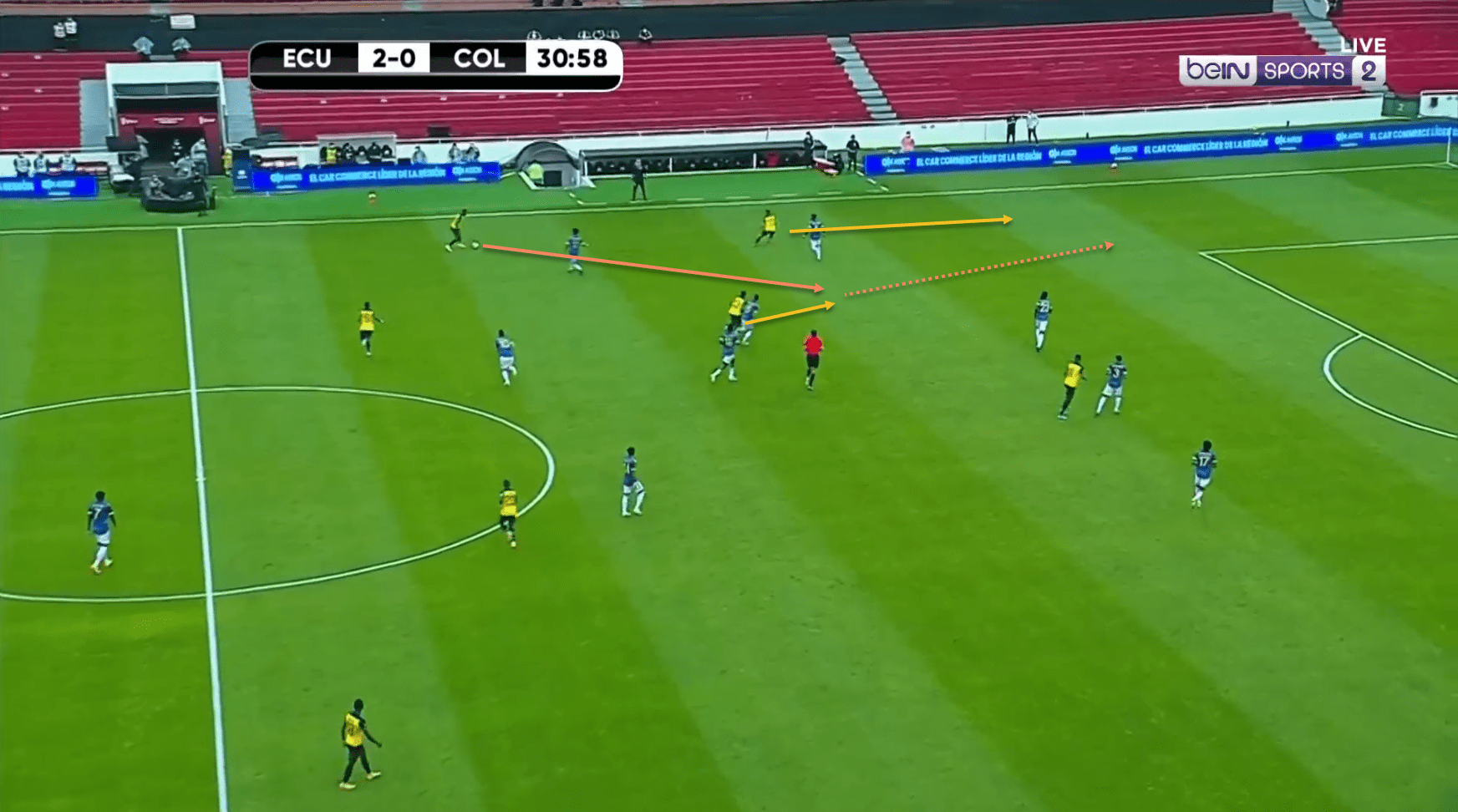
We can see an example of this here, as Estupiñán gets on the ball. The central midfielder Méndez is pushing into the wide spaces to receive possession, from where he is able to play the winger in behind. This sort of move is quite common for Ecuador.
El Tri also tend to make direct, vertical passes whenever possible, and while this does lead to them giving the ball away quite frequently, it also allows them to get into the final third quickly and efficiently.
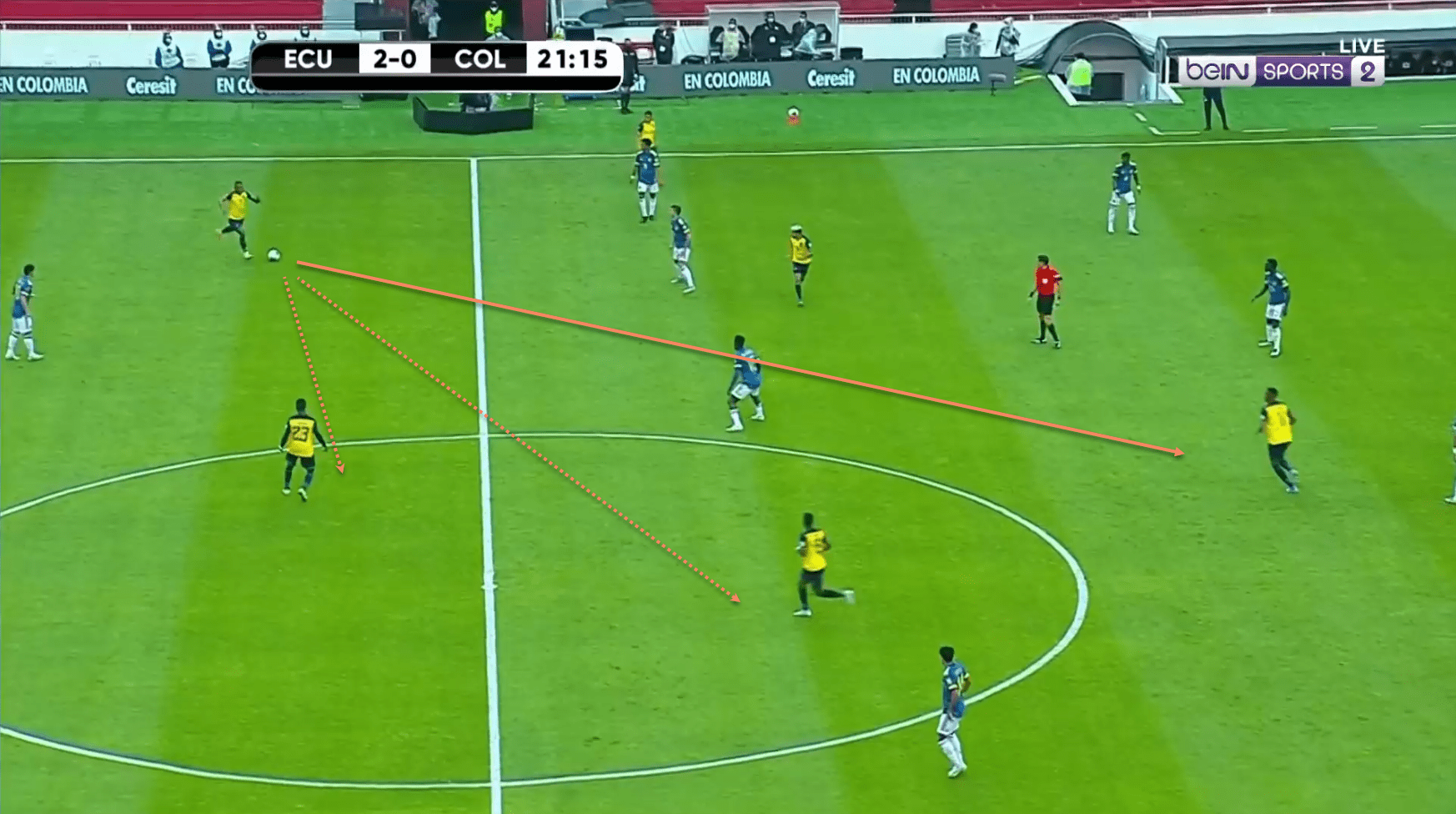
This instance is the perfect example of Ecuador’s directness in possession – Estupiñán has safer options to pass to, but he chooses to play a line-breaking pass to the striker instead. The move broke down since Estrada attempts an audacious backheel here – with a little more composure, he had the space to lay it off to a teammate instead and Ecuador would have been able to attack at speed.
Ecuador’s squad is well-suited to this approach, and they just need to have more composure and calm on the ball for moves such as this to develop into goalscoring opportunities.
DEFENSIVE PHASE
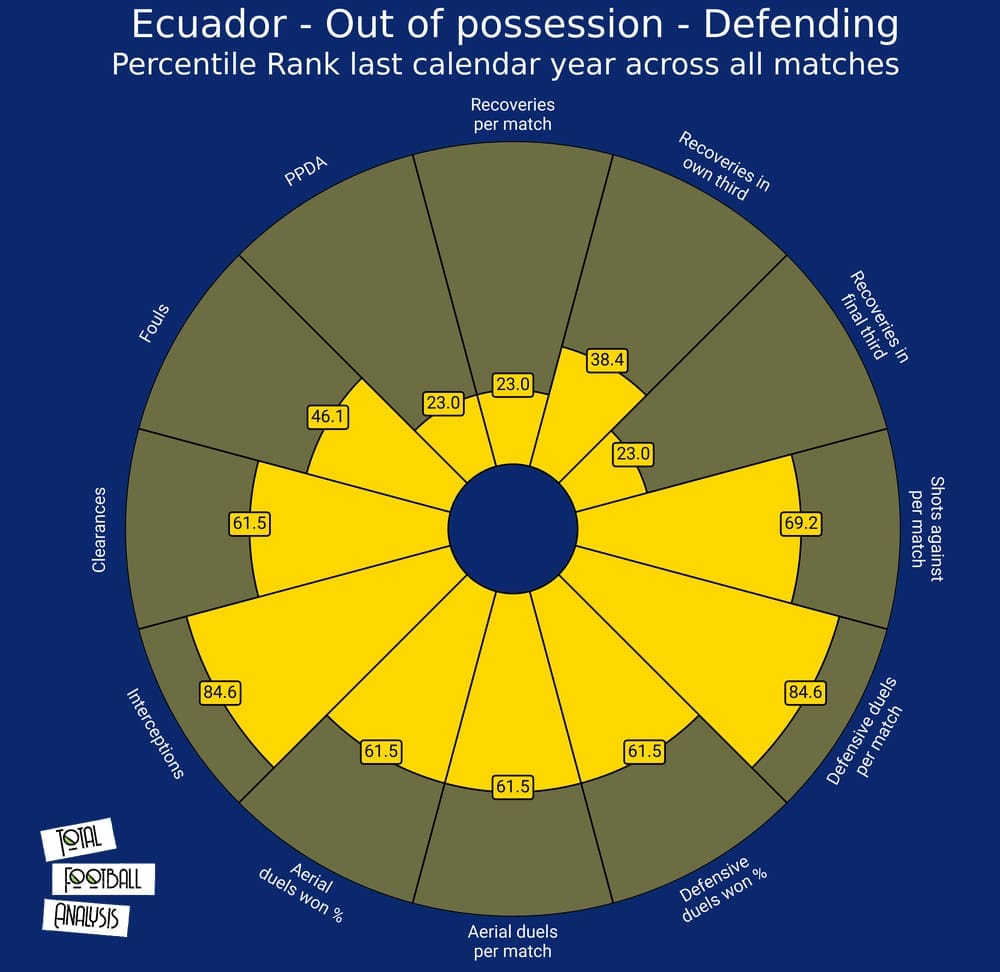
In terms of defensive approach, we can see that El Tri are a pretty aggressive side. They press quite intensely (23rd percentile rank for PPDA), but this seems to be a targeted press across the middle and defensive thirds, rather than across the pitch. An 84th percentile rank for interceptions suggests that they are good at blocking passing lanes in their defensive shape and stepping up to nick the ball away, while also being well above average for a host of other defensive metrics. They do concede quite a few shots per game (69th percentile rank), and this reflects the fact that they are not very good at winning the ball back, as seen by the low rank for recoveries per match (23rd percentile). The building blocks are in place, though, and Ecuador’s approach in defence will be crucial to their chances at the 2021 Copa America.
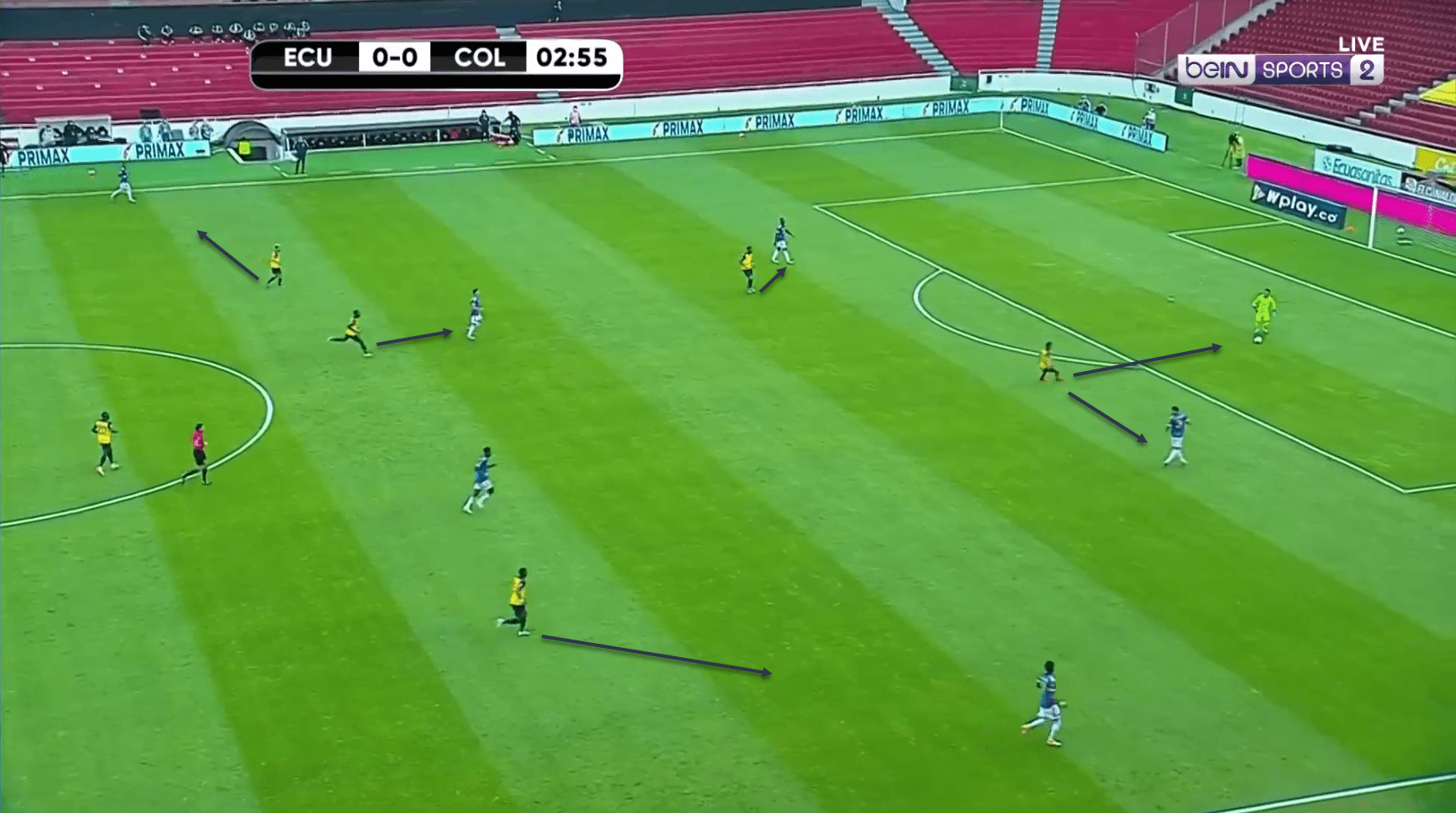
We have mentioned Ecuador’s tendency to press intensely, and while this is largely in their own half, they do step up and press high in the opposition’s half on occasion. Here, we can see how El Tri’s forward and midfield line is tracking all of Colombia’s players, except one.
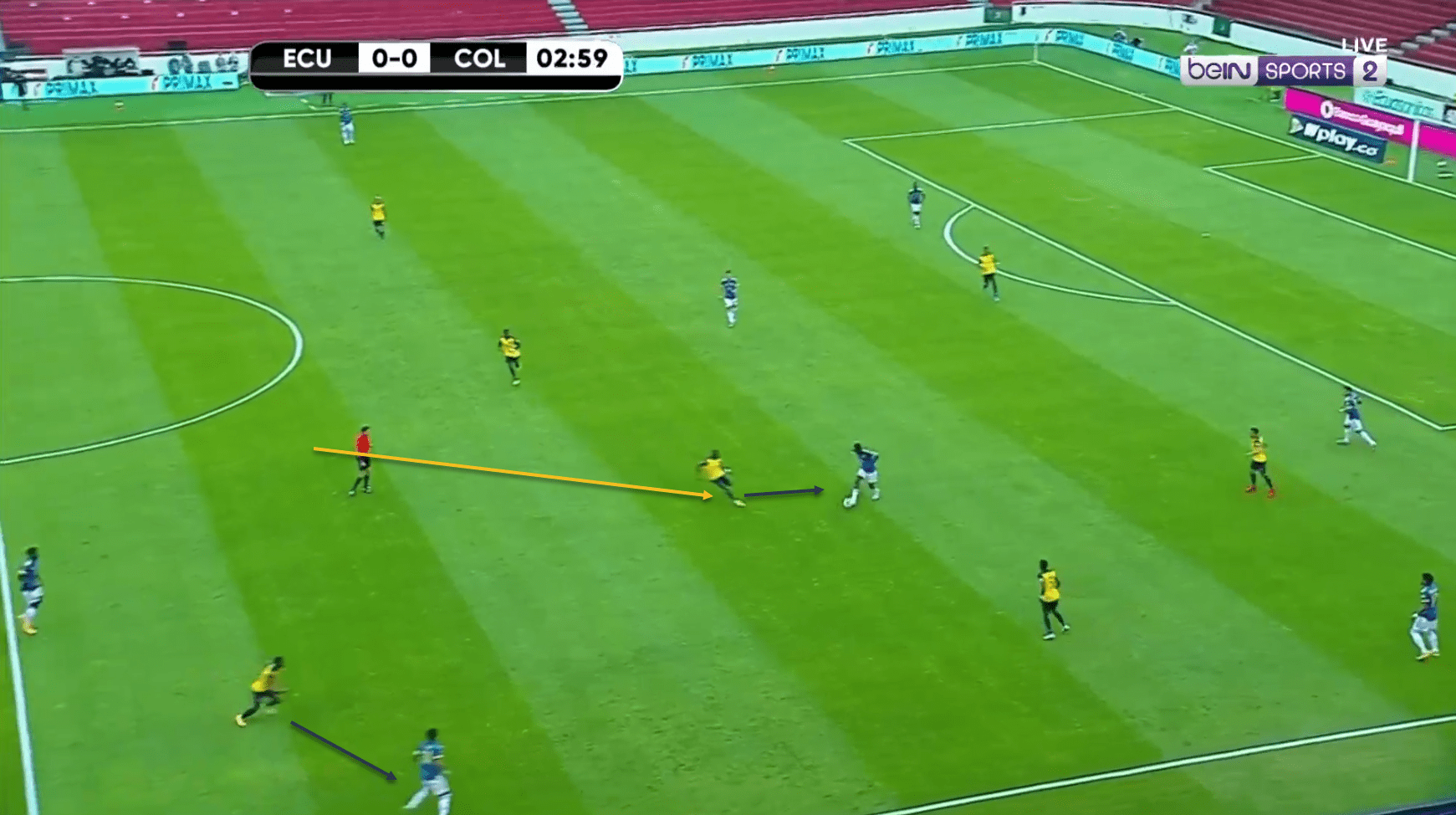
This was a pressing trap, designed to get the ball played into that player, which is when Caicedo rushes out to pressure him, and Perlaza moves up from right back to stick tight to the Colombian player on the wing.
However, we are far more likely to see Ecuador sitting back and looking to compress space centrally, in this manner –
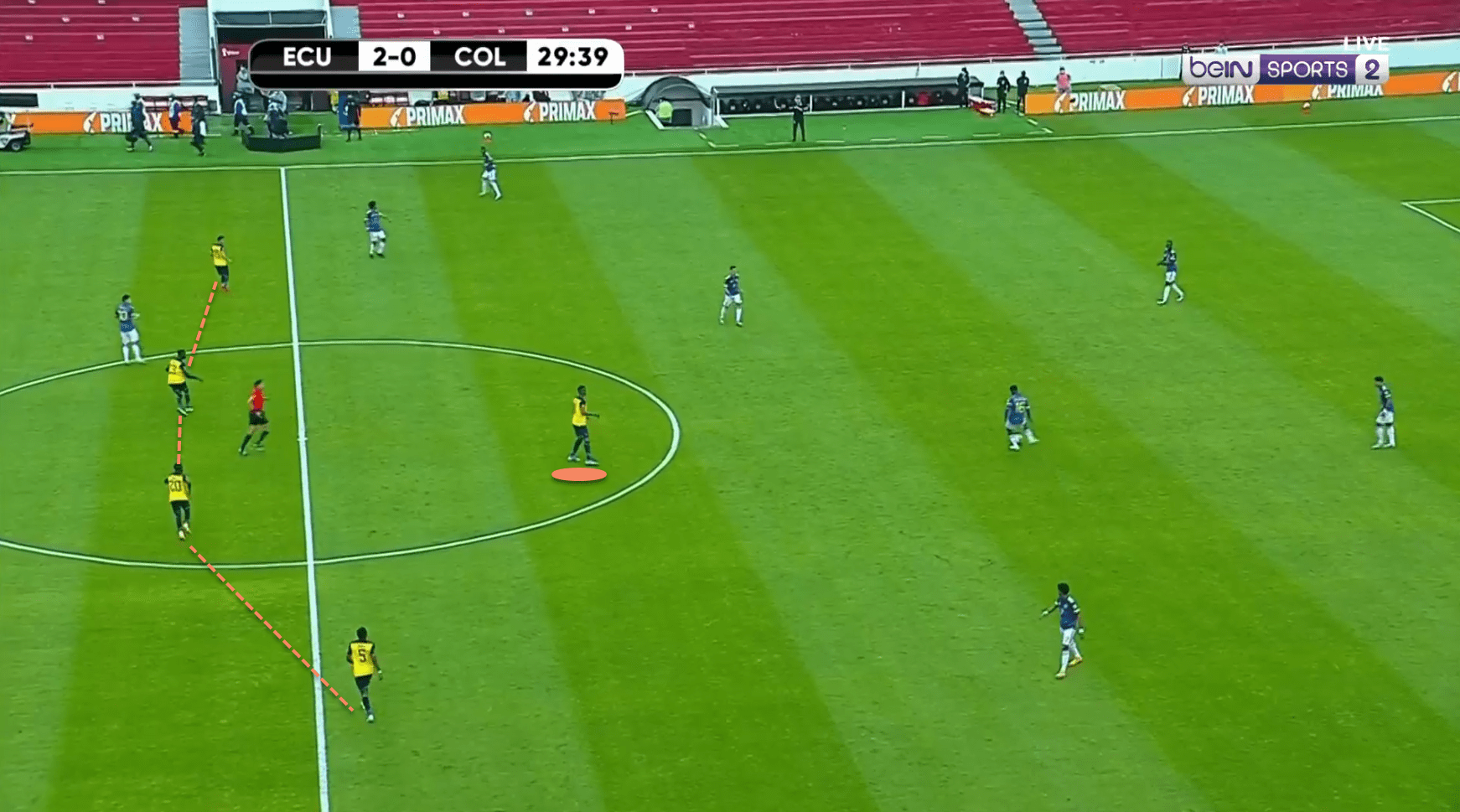
In general, Ecuador will be happy to let the opposition bring the ball into their half, which is when they will try to press in an aggressive manner and win the ball back before springing forward on the counter-attack.
TRANSITIONS
Ecuador utilise quick, direct passes to the flanks in offensive transition, with one of the central midfielders usually trying to spread the play wide. At the same time, if the ball is won back out wide, we can expect to see Estrada moving deep and wide to support, while the player on the ball will play it back and infield to a teammate in space, who can then pick out Estrada with the forward pass.
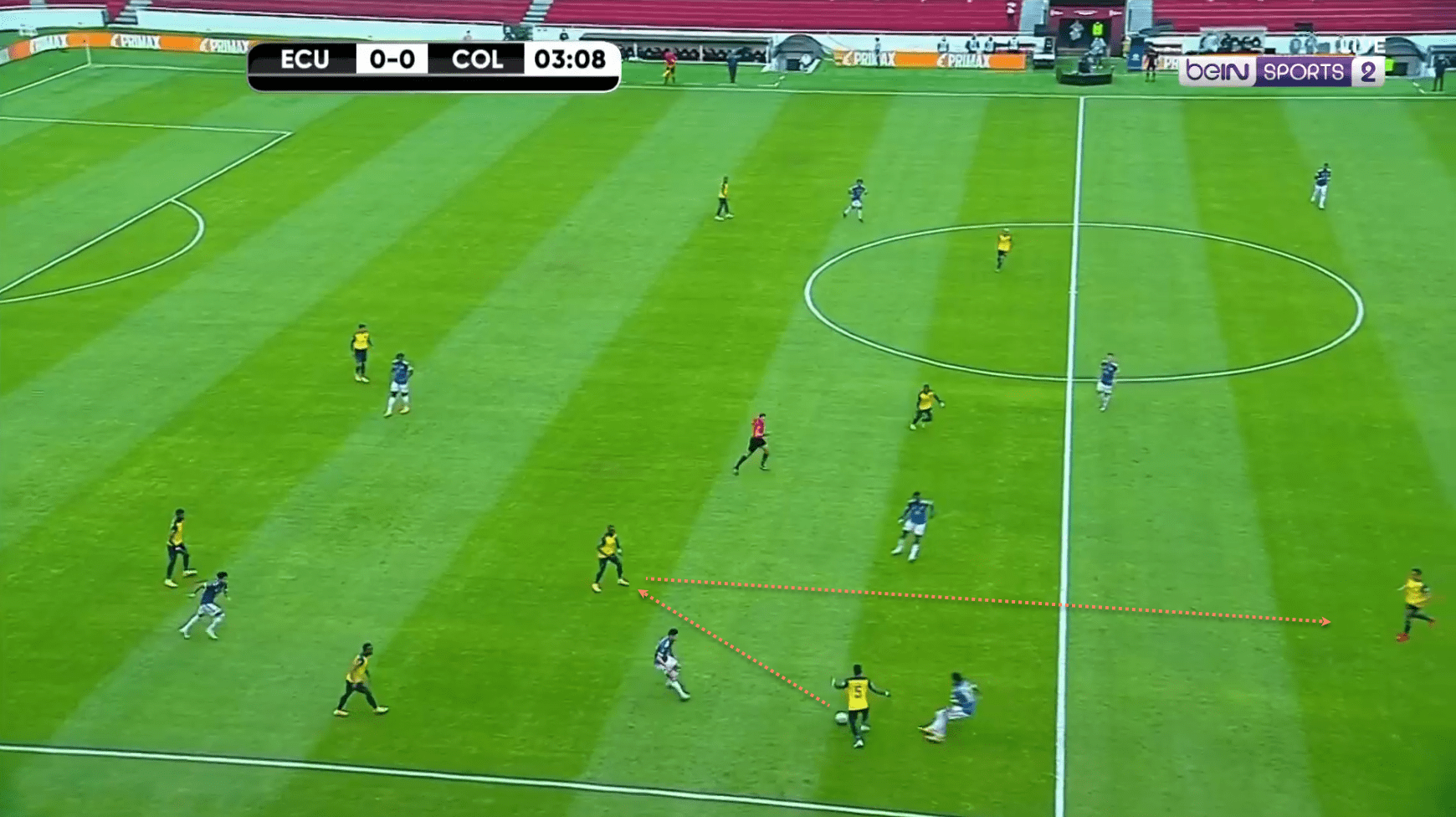
In defensive transitions, El Tri will try to press initially, and if that proves unsuccessful, the players will quickly get back into their compact and deep block.
FORWARDS
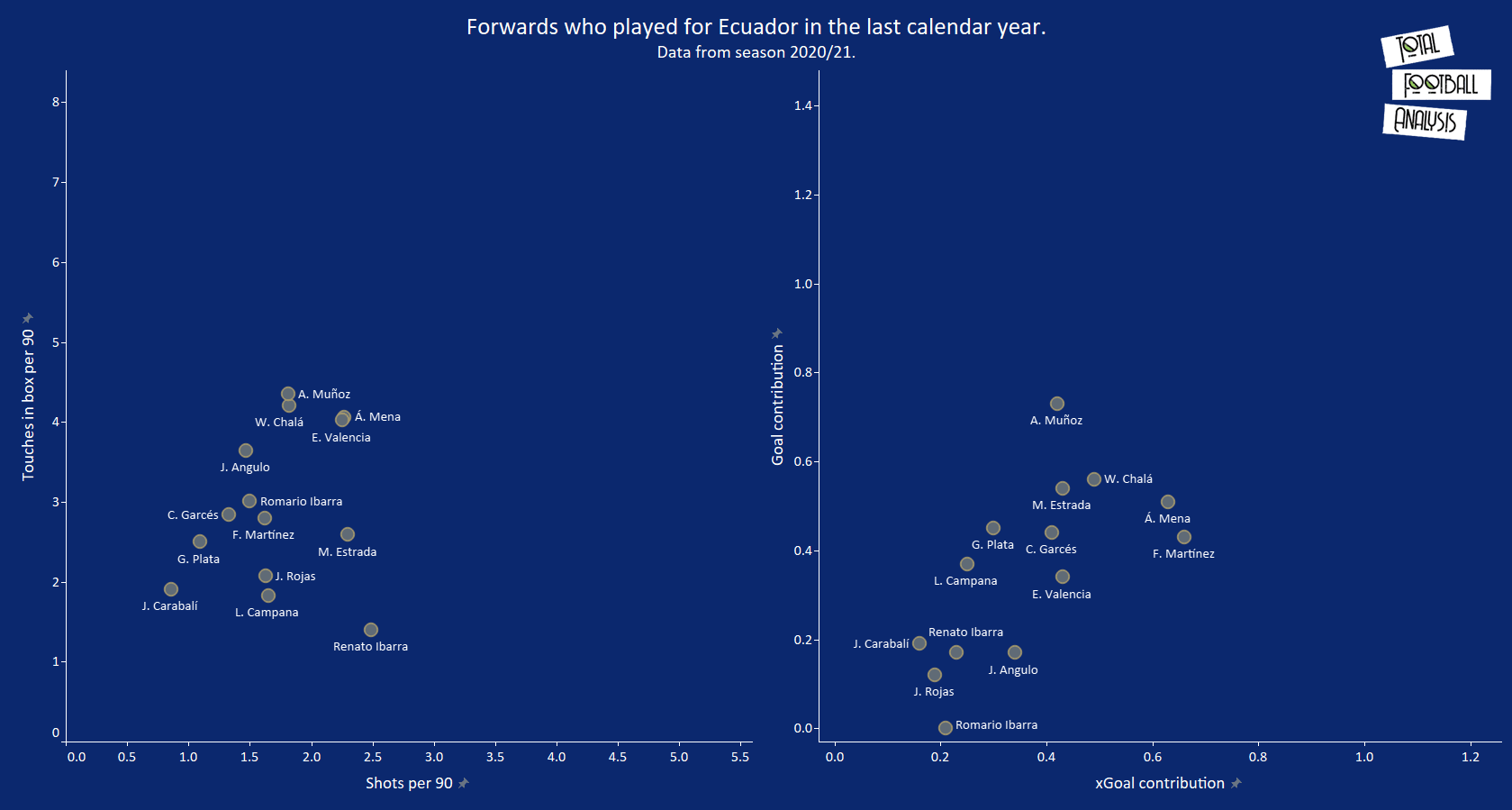
Our first comparison is between the various attackers available to Alfaro. We can see that none of the Ecuador forwards have been able to get too many touches in the opposition penalty area, and while this is also a reflection of their respective clubs’ playing styles, it is also what they can expect to see with Ecuador, as we have already seen how El Tri do not create too many chances. Estrada, the lead striker, has had decent numbers with regard to goal contribution, with Plata also potentially a crucial provider of chances. In general, this section does not look to promising, where several players will have to step up and improve their form if Ecuador are to score the goals to fire themselves into the quarter-finals.
MIDFIELDERS
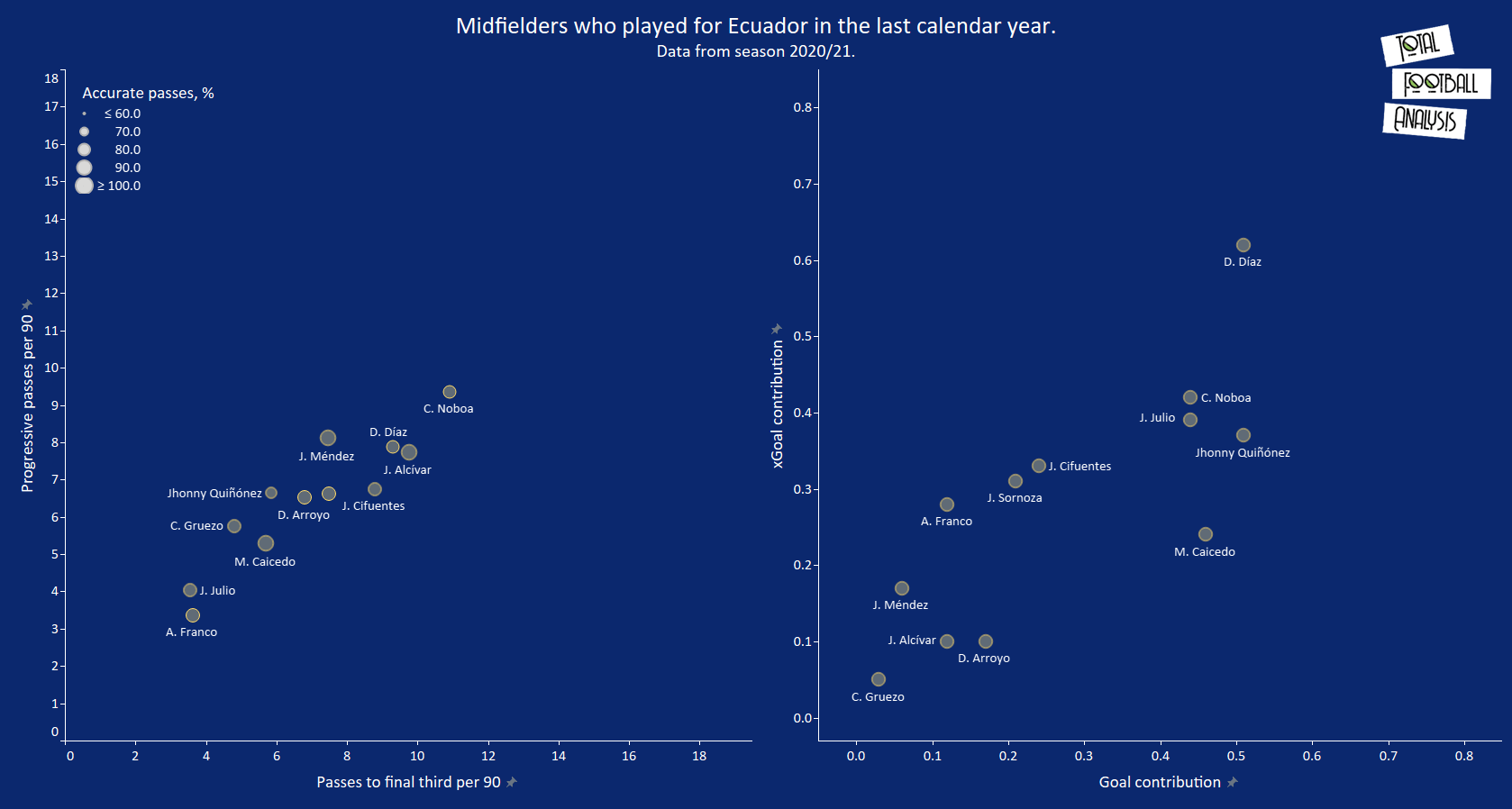
Next, we will look at Alfaro’s midfield options. In terms of creativity and ball progression, it is the 36-year-old Noboa who leads the pack, while the likes of Caicedo and Gruezo lag far behind. On this evidence, there may be a case for Noboa to start, provided he has younger players around him in midfield to do his running for him. Noboa also stands out when it comes to goal contribution (goals +assists) from those players in our predicted squad – the veteran has only scored four goals for Ecuador in 77 caps, but he may well add to those numbers at Copa America 2021. However, it is far likelier that he will be used as a defensive midfielder, with Caicedo, Gruezo, Franco and Cifuentes playing higher up the pitch. It is clear from this chart as well that Ecuador’s goal threat will have to come from their attackers, unless one of the midfielders steps up and surprises everyone.
DEFENDERS
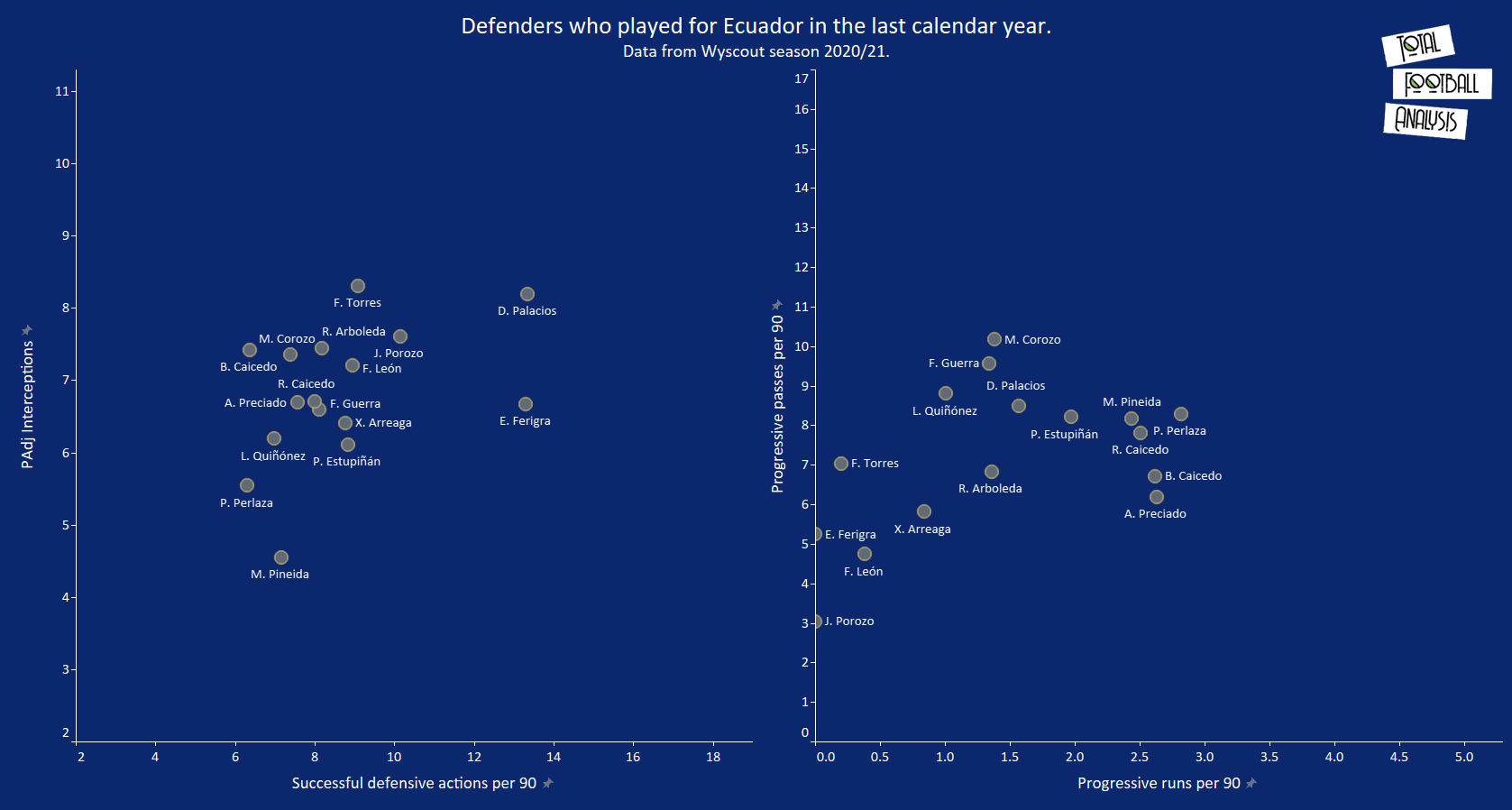
Lastly, we come to the Ecuadorian defenders. On the left-sided chart, we can see Arboleda as one of the better performers on both our metrics, with Arreaga not too far behind. Ecuador’s defence is likely to come under sustained pressure in many of their group stage games, and their centre-back pairing will need to be strong and robust. When it comes to ball progression, it is the right-back Preciado who is one of the most impressive candidates here in terms of progressive runs, while Estupiñán has been far more conservative. The two starting centre-backs are not too bad when it comes to progressive passes, but are certainly not among Ecuador’s best in this department, so we may expect to see the midfield taking up most of the responsibility for ball progression at Copa America 2021.
BEST PERFORMER
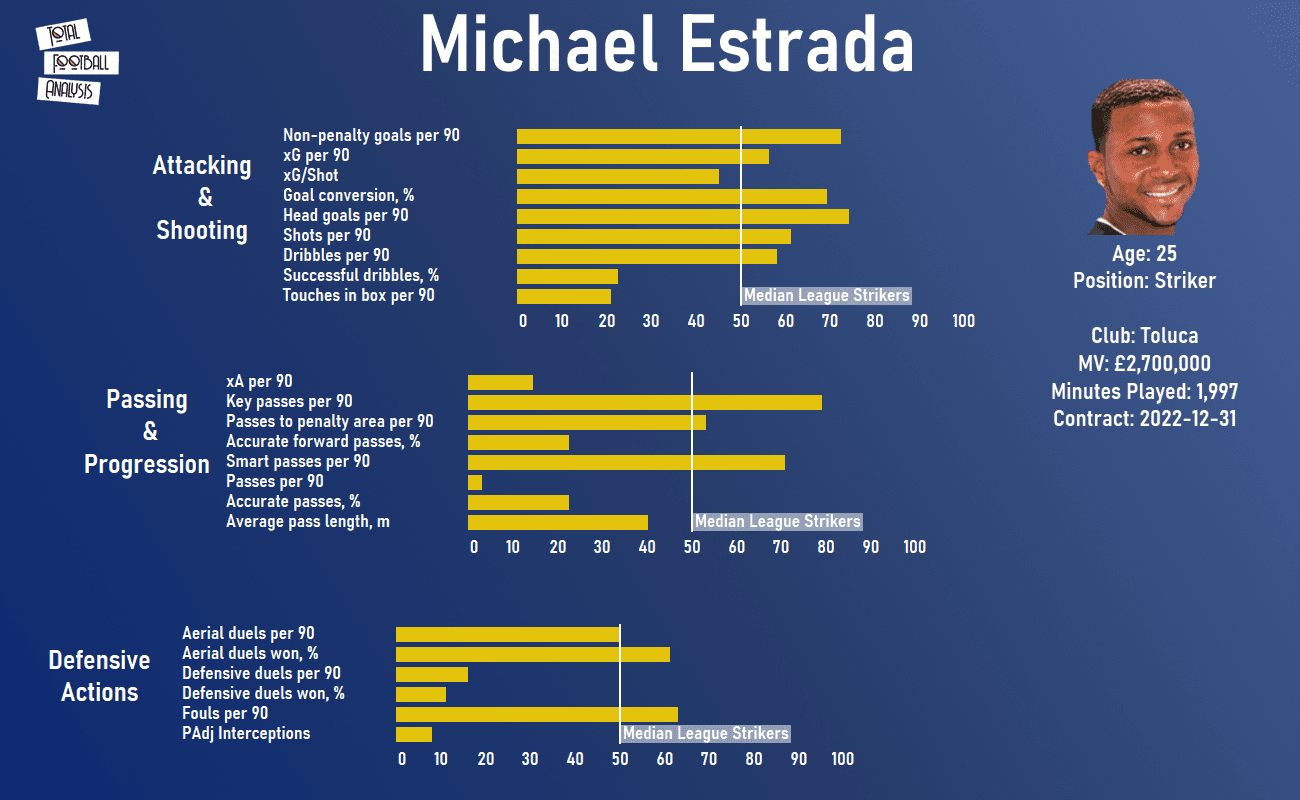
As the expected starting centre-forward, 25-year-old Michael Estrada will be one of the key players for Ecuador at this tournament, despite having just 13 caps for the national side so far in his career. He has been a constant in the side under Alfaro, and while he may sometimes have a strike partner alongside him, Alfaro has tended to use a lone striker on most occasions. Given Ecuador’s direct style of play, he will have to win his physical battles with the opposition centre-backs and win the ball in the air before laying it off for teammates, and also get into the box himself to provide a goalscoring threat.
In terms of attacking metrics, Estrada has been decent – around the 75th percentile for non-penalty goals per 90, and around a similar rank for headed goals per 90. This shows his aerial ability, as does the rank for aerial duels won %, and Ecuador will try to exploit this through crosses and long balls from deep. His goal conversion rate has also been far better than average this season, which bodes well for an Ecuador side that does not create too many chances. However, he may need to get into better positions before shooting, as his xG/shot is lower than the league average. This is also linked to his low rank for touches in the box – Estrada will need to get into the box a lot more to be a regular goal threat for Ecuador.
The 25-year-old will also play a role in terms of creativity, as we can see from the ranks for key passes and smart passes per 90. Given El Tri’s relative lack of attacking firepower, the Toluca striker will have a lot of responsibility on his shoulders as the leader of the attack.
PREDICTIONS FOR THE TOURNAMENT
The format of this year’s Copa America gives Ecuador a very good chance of making it into the quarter-finals, as only one team will be eliminated from each group. We expect them to finish in third or fourth place in Group B, which would bring a potential quarter-final clash against the likes of Chile or Paraguay, assuming that Argentina and Uruguay are the top two teams in Group A. Ecuador can realistically hope to beat either of these sides as well, so a semi-final run is not out of the question here. El Tri have the chance to go deep at this tournament because of its format, and they need to take advantage of this opportunity. We expect them to reach the quarter-finals at a minimum, where the identity of their opponent will be a huge factor in determining further progress.

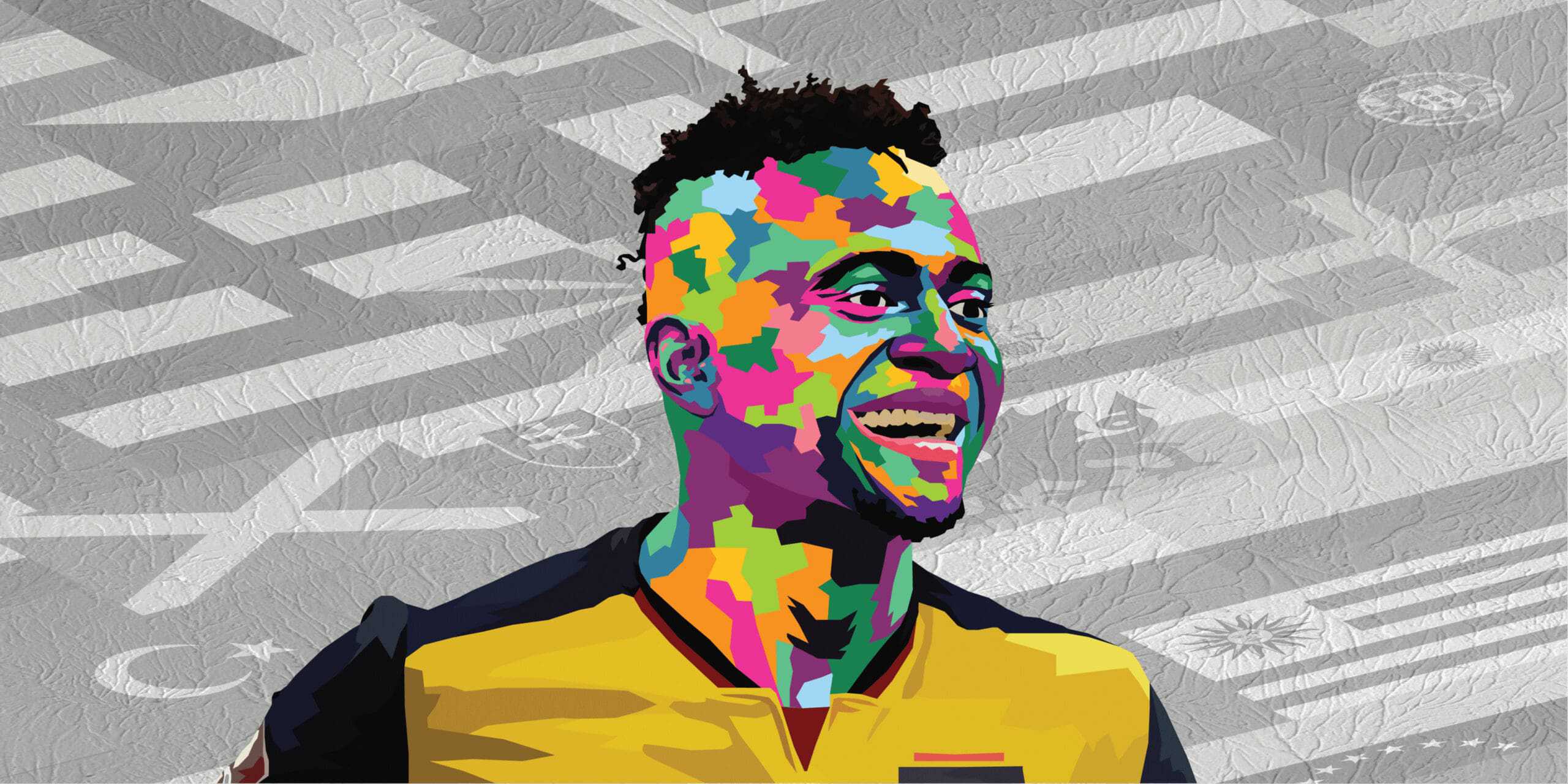



Comments